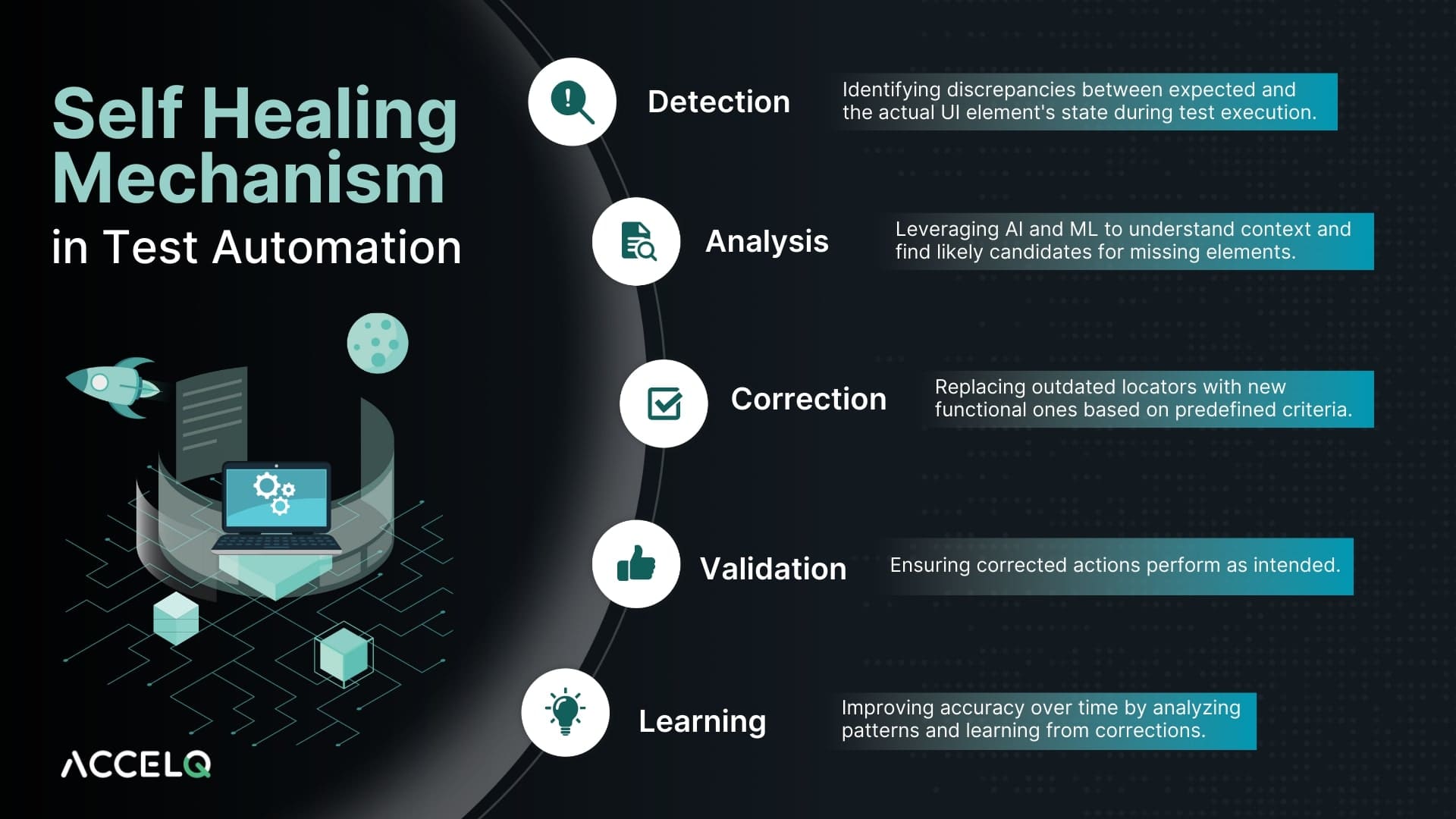Self-Healing Test Automation: A Comprehensive Guide

Over the years, application testing has evolved from manual execution to completely automated frameworks. However, traditional test automation can suffer from fragile scripts that fail due to the slightest change in the UI or the code. This causes maintenance efforts to be more costly and take longer to realize.
Enter self-healing test automation — a revolutionary technique harnessing Artificial Intelligence (AI) and machine learning (ML) to detect application changes and automatically update and repair test scripts accordingly. AI can unleash self-healing automation, which is what this article examines: how self-healing can reconfigure the entire testing process by significantly reducing manual intervention.
What Is Self-Healing Test Automation?
AI-driven algorithms in self-healing test automation identify, analyze, and dynamically update test scripts whenever application changes happen in the UI or the underlying code. In contrast to traditional automation that necessitates manual effort for even minor changes, self-healing test automation frameworks autonomously adapt and ensure uninterrupted execution.
Why Is It Needed?
This is because traditional test automation frameworks are built on static object locators (e.g., XPath, CSS selectors). When developers change UI elements — renaming a button or altering element positions, for instance — tests fail as they can’t find the elements anymore. This results in:
- Increased test maintenance
- Higher test failure rates
- Delayed software releases
- Reduced test coverage
How Self-Healing Automation Works
Self-healing test automation addresses such challenges by automating the test case update process when UI changes and updates take place. Here’s how it works:
- Detection – The framework detects that an element is missing or has changed.
- Analysis – AI algorithms analyze the UI to identify an alternative matching element.
- Adaptation – The framework updates the test script dynamically, replacing outdated locators.
- Validation – The modified test is executed to ensure correctness.
- Learning – The system continuously improves by learning from past fixes.
By automating script maintenance, self-healing test automation ensures that tests remain resilient even in dynamic environments.
Self-Healing Test Automation Example
Scenario: E-commerce Platform
Before Self-Healing Automation
- Problem: Frequent UI changes in an e-commerce site cause test failures (e.g., renaming the ‘Buy Now’ button to ‘Purchase’).
- Impact: Test scripts break, requiring manual script updates, increasing test maintenance costs, and delaying releases.
Before Self-Healing Implementation:
- Problem: Automated tests for the platform were brittle. Minor changes in the UI, such as renaming a button from “Buy Now” to “Purchase,” would cause tests to fail, necessitating manual updates to test scripts.
- Impact: High test maintenance costs, delayed releases, and reduced test coverage.
After Self-Healing Implementation:
Action: The test automation framework integrates self-healing capabilities.
Process:
- Action: The test automation framework integrates self-healing capabilities.
- Process:
- Detects test failure due to missing “Buy Now” button.
- Analyze the UI to identify the renamed “Purchase” button.
- Updates test scripts dynamically without manual intervention.
- Continues execution, ensuring minimal disruption.
- Outcome:
- 80% reduction in test maintenance efforts.
- Faster test execution cycles.
- Improved release velocity with minimal manual intervention.
Understanding the Self-Healing Mechanism
Self-healing mechanisms operate based on AI and ML models, continuously improving over time. Here’s a breakdown:
Detection
When an automated test fails to locate an element, the self-healing mechanism flags the issue and triggers an investigation.
Analysis
AI algorithms analyze the application’s UI, using attributes like:
- Element ID
- XPath/CSS selectors
- Text labels
- Relative position
Correction
The framework suggests and applies the best match for the missing element, ensuring test continuity.
Validation
The corrected test case is executed to verify that the changes do not introduce false positives.
Learning & Optimization
The system learns from past modifications to enhance prediction accuracy, reducing future test failures.
How Does Self-Healing Test Automation Work?
Self-healing test automation follows a systematic workflow:
- Real-time monitoring – Tracks application UI changes in real-time.
- Error detection – Identifies failed test cases due to element changes.
- Self-healing execution – Automatically fixes broken tests using AI-driven matching techniques.
- Continuous optimization – Improves detection and correction capabilities through ML.
By integrating self-healing automation scripts, organizations can ensure their test automation remains effective even in rapidly changing application environments.
Benefits of Self Healing Test Automation
1. Saves Time and Effort in Test Maintenance
Self-healing test automation reduces the need for frequent manual test updates, allowing QA teams to focus on higher-value tasks like test strategy and exploratory testing.
2. Reduces Test Failures
By automatically fixing test scripts, the failure rate of automation tests significantly decreases, leading to more stable CI/CD pipelines.
3. Prevents Object Flakiness
Self-healing test automation tools eliminate flaky tests caused by unstable locators, ensuring consistent test execution.
4. Improves Test Coverage
With reduced maintenance overhead, QA teams can expand test coverage to new features without worrying about test script stability.
5. Enhances ROI on Test Automation
Organizations investing in self-healing test automation experience lower costs in test maintenance, leading to faster releases and a higher return on investment (ROI).
Self-Healing Automation with ACCELQ
ACCELQ offers one of the most sophisticated self-healing test automation tools, including:
- AI-driven self-healing capabilities
- Visual test design with reusable components
- Enterprise-level cloud-based automation
- Seamless integrations with CI/CD pipelines
Organizations looking for a scalable and intelligent self-healing automation framework should consider ACCELQ to streamline test maintenance and enhance test reliability.
Conclusion
Self-healing test automation is a game-changer for software testing. By leveraging AI-driven automation, organizations can:
- Reduce test maintenance efforts.
- Minimize test failures due to UI changes.
- Improve test reliability and efficiency.
- Enhance CI/CD processes with stable automation.
AI-based self-healing automation is the most pragmatic approach to avoid the obsolescence of test automation as applications change rapidly, thus helping achieve speedy software releases with better-quality applications. ACCELQ's seamless, adaptive AI-powered automation platform is your gateway to self-healing test automation! If you sign up today for a 14-day free trial and transform the way you do test automation!
Geosley Andrades
Director, Product Evangelist at ACCELQ
Geosley is a Test Automation Evangelist and Community builder at ACCELQ. Being passionate about continuous learning, Geosley helps ACCELQ with innovative solutions to transform test automation to be simpler, more reliable, and sustainable for the real world.
Discover More
 What are the Causes of Failure in Test Automation? (And How to Avoid It)
What are the Causes of Failure in Test Automation? (And How to Avoid It)
What are the Causes of Failure in Test Automation? (And How to Avoid It)
 Test Automation for SaaS Applications – Best Practices
Test Automation for SaaS Applications – Best Practices

































